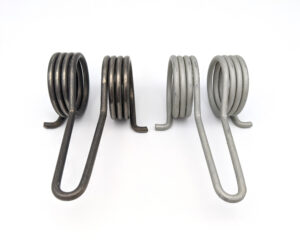Manufacturing double torsion springs requires precision, attention to detail, and consideration of wire diameter to satisfy customers and save money. Avoiding common errors is crucial for ensuring their functionality and longevity in various applications for customers using custom springs, saving money on wire.

Incorrect Direction of Operation
A critical aspect of double torsion spring design, especially for custom springs, is ensuring that each coil is wound in the correct direction for its intended use and considering the diameter of the torsional springs to work effectively. A common mistake is winding both cylindrical wound torsion springs in the same direction or misjudging the direction in which the large torsion springs should operate, especially with double body torsion springs where double torsion springs supply is critical. This can result in a cylindrical wound torsion spring or double coils that do not function as intended, potentially causing damage to the application or the spring itself, especially if sourced from a double torsion springs supplier. It is essential to verify the direction of wind and operation during the design phase to avoid costly errors.
Inside Diameter Too Small
The inside diameter of a torsion springs must be carefully calibrated. If it is too small, the double torsion springs may bind on the mandrel or the shaft it is meant to fit over during operation. This binding can lead to increased wear, friction, and ultimately, double torsion spring failure. Manufacturers must ensure that the inside diameter allows for free movement without excessive play, which could also affect performance in torsion spring design, especially with double torsion springs and acxess spring.
Body Length Too Large
When the body length of a torsion spring is too large for the space it is intended to occupy, springs can lead to binding or buckling. This not only impedes the double torsion springs’ function but can also cause premature wear or failure. Designers must account for the space constraints of the application and ensure that the double torsion springs’ body length is compatible with the available space.
Overstressing
Overstressing a torsion spring by designing springs to handle more torque than it can withstand is a common mistake. This can lead to metal fatigue and eventual breakage. To avoid this, engineers must calculate the maximum stress double torsion springs can endure during operation and design within those limits. Regular testing and validation of double torsion springs can help identify stress-related issues before the spring is put into use.
Neglecting Environmental Factors
Environmental factors such as temperature, humidity, and exposure to corrosive substances can significantly affect a spring’s performance and lifespan, especially for torsion springs. Selecting materials and coatings, such as torsion springs, that are unsuitable for the operating environment is a mistake that can lead to rapid degradation. For instance, springs used in marine environments should be made from corrosion-resistant materials or have protective coatings to prevent rust.
Improper Installation
Improper installation of a double torsion spring can introduce unintended stresses and lead to failure. It is crucial that installation guidelines are followed precisely. This includes ensuring that the torsion springs are seated correctly, the legs are aligned properly, and the spring is not twisted or distorted during installation. Proper training for installers can prevent these issues.
Overloading or Misuse
Subjecting a torsion spring to loads beyond its design capacity is a recipe for failure. Misuse, such as using torsion springs for an application they were not designed for, can also lead to overloading. Manufacturers should clearly communicate the load specifications and usage instructions to prevent overloading and misuse by end-users.
Lack of Regular Maintenance
Regular maintenance is vital for the longevity of double torsion springs. Without it, wear and tear on torsion springs can go unnoticed, leading to unexpected failures in double torsion spring systems and acxess spring applications. Maintenance routines should include inspections for signs of wear, corrosion, and deformation, as well as the application of lubricants where necessary.
Choosing the Wrong Material
The material selection for a torsion spring is paramount to its performance. A common mistake is choosing a material that cannot withstand the application’s demands, such as high temperatures or corrosive environments. Understanding the properties of different spring materials, including torsion springs, and their reactions to environmental conditions is essential for making the right choice.
Incorrect End Types
The ends of a torsion spring must be designed to interface correctly with the other components in the application. Using incorrect end types can prevent the spring from being properly anchored, leading to malfunction. It is important to consider the end type, such as the double torsion spring and acxess spring, during the design phase and ensure it is compatible with the mounting points in the application.
Conclusion
By understanding and addressing these common pitfalls in the design and manufacturing process, one can significantly enhance the performance and durability of double torsion springs.
Take the next step towards optimizing your double torsion spring applications by incorporating these insights into your design and manufacturing processes. Ensure excellence and reliability in every spring you produce.



